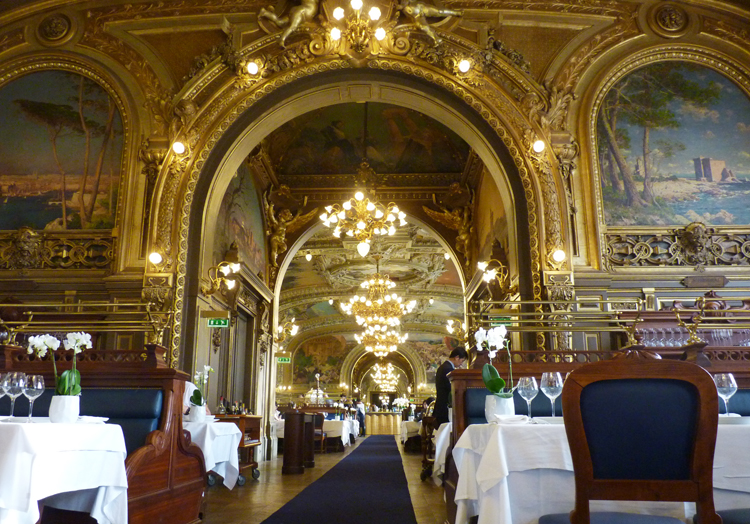It was 1900 and Paris was preparing to host a new Universal Exhibition. And as usually happens in these events, that was going to bequeath to the city a series of emblematic buildings built for the occasion, as was the case of the Grand and Petit Palais raised as fairgrounds. But, in addition to these pavilions, other Parisian infrastructures were built and remodeled.
The Gare de Lyon
Among them, the Gare de Lyon, the railway station of the company Paris-Lyon-Marseille that the architect Marius Toudoire completely renovated, giving it a grand facade and its huge Clock Tower that reaches 64 meters in height.
When contemplating even today the monumental façade we can think that the architect conceived the whole station as if it were an immense palace, with a wide vestibule open to a patio in the form of platforms for the travelers. However, in every palace there must be a great hall ready to dazzle visitors. Well, in this case it is the restaurant Le Train Bleu, which opened the following year, and still today can be visited on the first floor of the station.
A restaurant that is an Artistic Monument
The restaurant has remained virtually identical to its origins, even when it had to be saved from the demolition in the mid-1960s by the remembered French culture minister André Malraux. It is also true that in 2014 it was the object of a deep restoration that returned all its splendor. And in fact, Le Train Bleu has the category currently of Artistic Monument, which is a guarantee for its conservation.
In short, eating here is more than attending a banquet of genuinely French dishes. Sitting at these tables can stimulate the palate but above all excites the imagination while contemplating the stage.
A trip to La Belle Époque
Everything here smells, tastes, comes from the times of the mythical Belle Époque in Paris, when the French capital was the artistic capital of the world. In the same year that this restaurant was opened Rodin worked in marble his sculpture The Kiss, or Georges Meliés was finalizing the ideas for his film A Trip to the Moon, in part partly inspired by the stories of a Jules Verne who was a venerated author in Paris. Or that same year Toulouse Lautrec died, possibly the painter who best reflected that moment.
In this atmosphere of creative effervescence was designed the restaurant Le Train Bleu, which was also built following the plans of Toudoire, but for its decoration they had a large team of professionals and artists. Among them, they created the care of wooden furniture, the glass lamps, the upholstery, the moldings or the golds that decorate the great restaurant. Above all several painters participated for the decoration of the ceiling. Some paintings that might be thought to be a fresco, but actually are canvases pierced to walls, ceilings and vaults.
There are up to 41 scenes in which you can see the landscapes that crossed the trains of the company Paris-Lyon-Marseille. All of them of very ornamental character, as it is typical of the Art Nouveau style in which they were painted. In short, you sit down to eat or have dinner and you can hardly notice what they serve on the plate, since inevitably the gaze is directed to all that atmosphere, capable of taking us to the dream of another era.
Illustrious commensals
That ability to awaken the imagination, and the admiration, is manifested in any diner who comes or has come to these rooms. In addition, thousands and thousands of people have passed through here and from any origin, taking into account its location in a railway station. So all of them, travelers, lawyers, businessmen or simple tourists, have been able to ignite the creative flame seated at these tables.
Well, now we have to imagine those effects in the most illustrious characters who declared themselves passionate about this restaurant, its cuisine and its decoration. Characters of any artistic discipline, from the designer Coco Chanel to the writer Jean Cocteau, passing by Salvador Dalí, the actress Brigitte Bardot or the filmmaker Luc Besson who has come here to shoot scenes of some of his films.
With a view to the 21st century
The two dining rooms of Le Train Bleu open with huge windows, on one side to the Place Louise Armand where the facade of the Gare de Lyon is located, and on the other to the lobby and the platforms of the station.
And yes, fortunately, the diners in the table next to these windows will discover a contrast of the most suggestive. If you look at the ceiling, you can admire paintings that evoke the south of France in the early twentieth century, while if we turn to the window we jump in time, since before our eyes rests the great jewel of the current French railways, the TGV.
Trains that within the range of conventional railways are the fastest in the world as they reach speeds of up to 320 km/hour. Trains connecting much of the French territory and that from the Gare de Lyon link the gala capital with the south of the country, but also with Switzerland or Italy. Further, in these same platforms we also find the trains of high speed that unite several times a day Paris with Barcelona.
Anyway, wherever you look Le Train Bleu is more than just a restaurant. A place for travelers of our time with the enormous charm of proposing a tasty virtual journey, both towards the past and the future.
Useful information
Restaurant LE TRAIN BLEU
Gare de Lyon
Place Louis Armand
75012 Paris
Capacity for 200 people
Average menu price: 65 euros
TGV France-Spain
Renfe – SNCF in Cooperation joins 21 destinations of the two countries, including the four daily connections between Barcelona and Paris.
Duration of the trip: 6 hours and 19 minutes.
Https://www.renfe-sncf.com
Translated by: Raquel Sanchez












